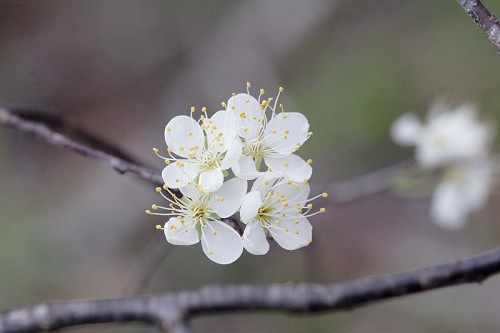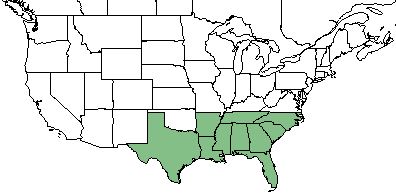Difference between revisions of "Prunus umbellata"
(→Ecology) |
(→Ecology) |
||
| Line 38: | Line 38: | ||
Flowering occurs typically between January and April, the majority of the budding in March. <ref name= "Pan Flora"> [http://www.gilnelson.com/PanFlora/ Pan Flora]</ref> | Flowering occurs typically between January and April, the majority of the budding in March. <ref name= "Pan Flora"> [http://www.gilnelson.com/PanFlora/ Pan Flora]</ref> | ||
<!--Timing off flowering, fruiting, seed dispersal, and environmental triggers. Cite PanFlora website if appropriate: http://www.gilnelson.com/PanFlora/ --> | <!--Timing off flowering, fruiting, seed dispersal, and environmental triggers. Cite PanFlora website if appropriate: http://www.gilnelson.com/PanFlora/ --> | ||
| − | + | ||
| + | ===Seed dispersal=== | ||
| + | This species is thought to be dispersed by consumption by vertebrates. <ref> Kirkman, L. Katherine. Unpublished database of seed dispersal mode of plants found in Coastal Plain longleaf pine-grasslands of the Jones Ecological Research Center, Georgia.</ref> | ||
<!--===Seed bank and germination===--> | <!--===Seed bank and germination===--> | ||
===Fire ecology=== | ===Fire ecology=== | ||
Revision as of 15:19, 4 September 2018
Common names: hog plum [1]
| Prunus umbellata | |
|---|---|

| |
| Photo by John Gwaltney hosted at Southeastern Flora.com | |
| Scientific classification | |
| Kingdom: | Plantae |
| Division: | Magnoliophyta - Flowering plants |
| Class: | Magnoliopsida - Dicots |
| Order: | Rosales |
| Family: | Rosaceae |
| Genus: | Prunus |
| Species: | P. umbellata |
| Binomial name | |
| Prunus umbellata Elliott | |

| |
| Natural range of Prunus umbellata from USDA NRCS Plants Database. | |
Contents
Taxonomic Notes
Synonym: Prunus mitis (Beadle), Prunus injucunda (Small)
Variety: none
Description
P. umbellata is a perennial shrub/tree of the Rosaceae family that is native to North America. [1]
Distribution
P. umbellata is found throughout the southeastern United States; specifically, Florida, Georgia, South Carolina, North Carolina, Tennessee, Alabama, Mississippi, Louisiana, Arkansas, and Texas. [1]
Ecology
Habitat
Habitats for P. umbellata include upland, sandy or rocky forests and woodlands. [2] Specimens have been collected from loamy sands of disturbed areas, ridge thickets, pineoak woodland and along fencerow, old golf course, longleaf pine-oak woodland, hedgerow in field, upland pine woodland, mixed deciduous woodland, low shrub, quarry area, hammocks, beach ridge, and flodplain. [3]
Phenology
Flowering occurs typically between January and April, the majority of the budding in March. [4]
Seed dispersal
This species is thought to be dispersed by consumption by vertebrates. [5]
Fire ecology
Prunus umbellata is more common in regions that are unburned. [6]
Use by animals
Wildlife, particularly mammals, only use it for a small amount of their diets. [1]
Conservation and Management
Cultivation and restoration
Photo Gallery
References and notes
- ↑ 1.0 1.1 1.2 1.3 USDA Plant Database
- ↑ Weakley, A. S. (2015). Flora of the Southern and Mid-Atlantic States. Chapel Hill, NC, University of North Carolina Herbarium.
- ↑ URL: http://herbarium.bio.fsu.edu. Last accessed: June 2018. Collectors: Loran C. Anderson, R.K. Godfrey, Delzie Demaree, John Nelson, Sidney McDaniel, Brenda Herring, Don Herring, L.G. Plank, H. Kurz, Robert Simmons, Bruce Hansen, Richard P. Wunderlin, Norma Mawhinney, Gary Knight, Patricia Elliot, Gwynn Ramsey, Richard Mitchell, D.L. Fichtner, L.J. Brass, O.Lakela, George M. Riegler, R. Komarek, Richard R. Clinebell II, Annie Schmidt, Richard Carter, Pat Ferral , Whit Gibbons. States and counties: Florida (Okaloosa, Franklin, Gulf, Leon, Gadsden, Jefferson, Jackson, Liberty, Madison, Bay, Columbia, Wakulla, Sumter, Washington, Lafayette, Suwannee, Dixie, Holmes, Highlands, Pasco) Georgia (Wheeler, Decatur, Grady, Thomas) SOuth Carolina (Orangeburg)
- ↑ Pan Flora
- ↑ Kirkman, L. Katherine. Unpublished database of seed dispersal mode of plants found in Coastal Plain longleaf pine-grasslands of the Jones Ecological Research Center, Georgia.
- ↑ Mehlman, D. W. (1992). "Effects of fire on plant community composition of North Florida second growth pineland." Bulletin of the Torrey Botanical Club 119(4): 376-383.